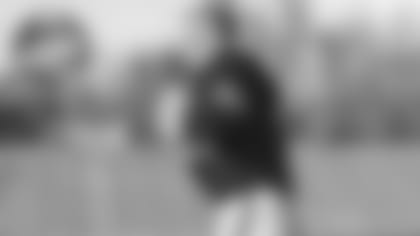*Packers quarterback Randy Duncan poses in an undated photo
*
As teams desperate for a top-end quarterback weigh the risk and rewards of drafting one No. 1, the Green Bay Packers have been able to bask in the comfort of not having that worry for a quarter-century.
At the same time, they've been there, done that.
As blessed as the Packers have been with outstanding passers over their 96 seasons in the NFL, there also have been times when they've been in the problematic position of having a desperate need at quarterback. And five times since the first NFL Draft in 1936, their choice of a first-round QB has backfired.
Here's the worst to first of those picks based largely on the cost. Also listed are the year the player was drafted and the overall choice expended.
1. Randy Duncan, 1959, No. 1 – With two games remaining and the Packers headed for a 1-10-1 finish, in a year when the first four rounds of the draft were held on Dec. 2, 1958, they selected the quarterback who would be announced that same day as the runner-up in the Heisman Trophy voting. Duncan also was the consensus All-American at his position and would lead Iowa to a lopsided 38-12 Rose Bowl victory. However, before draft day ended, Joe Taylor, who was both sports director of radio station WRIT in Milwaukee and equipment manager of the Milwaukee Braves, reported Duncan's father and Iowa coach Forest Evashevski "do not want the boy to play for the pros." Meanwhile, Duncan admitted he was thinking of attending law school rather than playing pro football. In February, Duncan turned down the Packers' offer and signed with the British Columbia Lions of the Canadian Football League for more money. Duncan played sparingly for the Lions over two years and then served as the backup quarterback for the Dallas Texans of the American Football League for one year. He completed a mere 25 of 67 passes and went to law school rather than continue his career.
2. Rich Campbell, 1981, No. 6 – On the morning of the draft, Bart Starr informed Dick Corrick, the Packers' personnel director, that he was going to take Campbell and all but anoint him his quarterback of the future. The night before, Corrick was under the impression he had finally convinced Starr to select defensive back Ronnie Lott over Campbell if both were available. After the Packers took Campbell, who played at the University of California, Tampa Bay selected linebacker Hugh Green sixth and San Francisco grabbed Lott, who is now in the Pro Football Hall of Fame, eighth. In the Packers' draft room, when the Campbell pick was relayed to the NFL's draft central, the team's West Coast scout Lloyd Eaton turned to then assistant to the president Bob Harlan and muttered, "That's a bad choice." Harlan asked why. "He can't play," Eaton responded. Eaton had Campbell pegged perfectly. He played in seven games in four years, never advancing above third string.
3. Stan Heath, 1949, No. 5 – The Packers actually drafted Heath twice. In 1948, they selected him in the 25th round, only to learn he wasn't eligible for the draft. The next year, they chose him 226 picks earlier after Heath, who played at Nevada, led the nation in passing and finished fifth in the Heisman voting. The Packers had switched to a version of the T-formation in 1947 and were desperate for a T-style quarterback. But Heath wasn't the answer. He played one year with the Packers, couldn't beat out converted halfback Jug Girard at quarterback and finished with one of the most abysmal stat lines in the history of the NFL: 26 completions in 106 attempts, 24.5 percent, with one touchdown and 14 interceptions. On Aug. 1, 1950, he was waived at his own request. Heath tried out with the Cleveland Browns in 1951, but couldn't pass Paul Brown's mental exam. In the end, his pro career consisted of five seasons in the CFL.
4. Jerry Tagge, 1972, No. 11 – Starr and Zeke Bratkowski played their last seasons in 1971, and Dan Devine, who had faced Tagge in college while he was coaching the University of Missouri, plucked him to compete with holdover Scott Hunter for the starting job. Tagge had been a high school star at Green Bay West and had led Nebraska to back-to-back national championships. Tagge started the last five games in 1973 and the first six in 1974, but was replaced by journeyman Jack Concannon. Starr took over as coach the next season and cut Tagge. He lacked arm strength. He was ponderous in the pocket. He was immature and inconsistent. In his three seasons with the Packers, he had a 48.4 completion percentage with three TD passes and 17 interceptions. He did better in the CFL, where he played from 1977-79 and was named all-league quarterback his first season.
5. Ernie Case, 1947, No. 6 –With plans to switch from his Notre Dame Box to a version of the T and coming off a season in which Irv Comp, as the primary passer, completed just 28.7 percent of his passes, Curly Lambeau took Case, a left-handed thrower from UCLA that he had watched in the Rose Bowl. Case was 26 years old and had been an Army pilot during World War II. After lettering at UCLA in 1941, he missed three seasons before lettering again in 1945 and '46. As a senior, Case led UCLA to its first-ever unbeaten, untied regular season. However, when the Packers drafted him, they were short on cash and Case opted to sign a three-year contract with Baltimore of the rival All-America Football Conference. Case injured his left shoulder and played mostly defense as a rookie. He was released, signed by the 49ers, who were then in the AAFC, and cut in camp.















